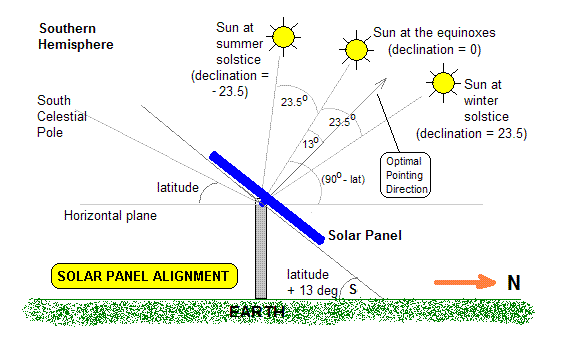
In a solar photovoltaic power system, each panel should ideally track the Sun during the day to obtain the maximum possible energy. Unfortunately this is often too expensive to implement, and most small solar power systems employ fixed panels. The question then becomes as to what direction the panels should be mounted.

The Sun not only moves across the sky from east to west during the day - it also slowly oscillates from north to south and back again with the seasons. Since the daily motion is symmetric with respect to the local meridian (north-south line), the azimuth of the panels is without question toward the north in the southern hemisphere, and toward the south in the northern hemisphere.
This leaves the elevation of the panel to be determined. With reference to the above diagram, the Sun moves from a declination of -23.5 degrees at the summer solstice (southern hemisphere) through zero declination at the autumnal and vernal (spring) equinoxes to a declination of +23.5 degrees at the winter solstice. This motion is not uniform - the Sun moves more quickly around the equinoxes than around the solstices. It is however, symmetric about the point of zero declination, which lies at an elevation of 90 degrees minus the southerly latitude from the ground, along the north-south. In the diagram, the latitude is around 30 degrees, and so the point of zero declination is at an elevation of 60 degrees from a line pointing due north.
It might thought that because of this symmetry, the optimum elevation of a solar panel is such that it should point toward the position of zero declination. This however, is not the case. The reason is that the days in winter are shorter. It is necessary to compensate for this by tillting the panel more toward the north. This means the panel will subtend a greater area toward the Sun in the winter months, and compensates to some extent for the loss of power at this time.
It has been found empirically that the best compromise at mid-latitudes is to point the panel to a declination of 13 degrees. This is done by making the angle between the panel and the horizontal equal to the site latitude plus 13 degrees. Thus in the diagram the angle S will be 30 + 13 = 43 degrees.
In general the optimum angle S = | latitude | + 13 degrees.
The two vertical lines enclosing the latitude indicate that we are to take the absolute value of the latitude. Thus 30o S will be taken as +30o.
In the northern hemisphere the diagram will be reversed and the angle S will be from a line pointing toward the south.
 Australian Space Academy
Australian Space Academy